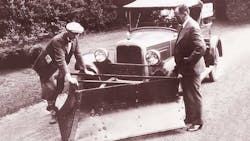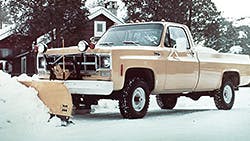MEYER PRODUCTS has come a long way since a blustery winter day in 1926 when Edward B Meyer took on Mother Nature by putting a wooden moldboard on the front of a Buick to clear his driveway on a farm in Newburgh, New York, giving birth to the Meyer Auto Snow Plow Company.
It didn’t take long for Meyer to switch the moldboard from wood to steel. Here are some of the other improvements the company introduced in 90 years of manufacturing snow and ice control equipment:
Hydraulic lifts. Soon after it began making moldboards out of steel, Meyer introduced a hydraulic lift system to make them adjustable.
In the 1960s, car and truck dealerships incorporated Meyer plows on their vehicles to increase sales. Meanwhile, snow pros looked to Meyer for a commercial-grade plow for round-the-clock use. The company also introduced “Power Angling” in the 1960s. This enabled operators to move the plow blade left or right without having to leave the comfort of the cab. Power angling is as popular now as power steering on cars.
In the 1970s, Meyer rolled out began offering snowplow headlights and introduced a “Mini-Spreader” to combat ice.
The 1980s brought the Slik-Stik, a single electric switch to give operators the ability to quickly move the height and angle of the plow.
In the 1990s, Meyer began offering high molecular polymers as an option for steel. And at a time when personal computers were coming into their own, the company also applied some of that new technology, launching “Electro Touch Control” to provide total electronic moldboard control. During the same period, Meyer swapped the fiberglass design of its spreaders, using high-tech thermo plastic instead.When Andy Outcalt took over as Meyer’s president in 2006, the changes continued.
“We had a lot of redundancy in the product lines. I knew we definitely had to modernize. The automation side at Meyer had a real opportunity to significantly improve operations, so we added lasers, robotic fixtures, and robotic welding machines. We did a lot of work in the plant, changed lot of processes from the old bend, push together, and weld, to more slot-and-tab construction, continuous welding, and a lot of things that beef up the products and standardize.
“That takes time, energy, and culture change. That was a big investment on the owners’ side. We put over eight years and $15 million to $16 million of investment into this place.”
Meyer also converted its entire facility to computers, redesigned its entire plow line for added strength, reliability and ease-of-use, added a wide variety of spreaders—including the Crossfire with an integrated pre-wet system—and developed an electronic plow configurator.
This year, Meyer celebrates its 90th anniversary with year-long activities planned to celebrate the occasion.
“We like to think that we reinvent our business every day,” Outcalt says. “We are constantly looking for the unmet needs of our customers. In the cyclical ice and snow business, our eyes are always on the future and anticipating the demands of our marketplace.” ♦
About the Author
Rick Weber
Associate Editor
Rick Weber has been an associate editor for Trailer/Body Builders since February 2000. A national award-winning sportswriter, he covered the Miami Dolphins for the Fort Myers News-Press following service with publications in California and Australia. He is a graduate of Penn State University.




